Last Updated on 11/05/2020 by Veronica Jones
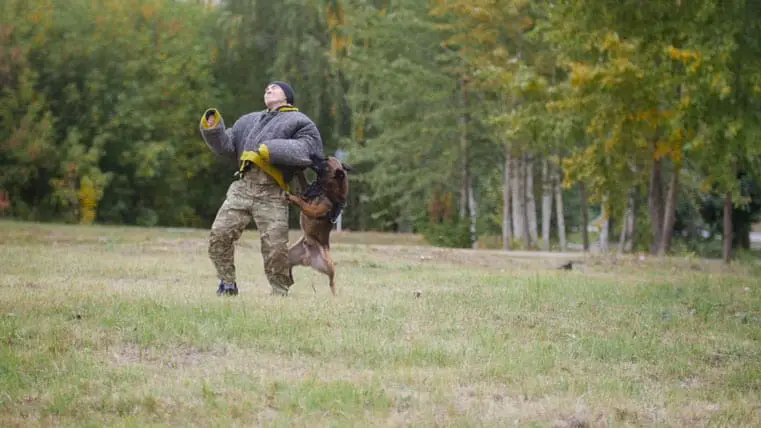
You probably know that your dog has a stronger jaw than you, but you may not have realized just how powerful a dog’s jaw really can be. Here’s what you need to know about how we measure jaw strength in dogs and which breeds have the strongest bite.
Measuring dog bite strength
If you want to find out which dog breeds have the strongest bite, you first have to be able to effectively measure the strength of the dog’s bite. This may seem like it should be a pretty straightforward experiment, but in fact a fair number of studies have been conducted in an attempt to determine the actual strength of a dog’s bite.
After all, the strength with which a dog bites requires a dog’s deliberate action, so the force may depend on the dog’s volition, any pain in the mouth, and experience biting as well as the actual strength in the dog’s jaw.
Studies that used a measuring device covered with flavored rawhide to measure bite strength found that results vary dramatically depending on the dog’s chewing enthusiasm and eagerness rather than just by bite strength. Another study replaced some of the dog’s teeth with a sensor, but it was found that in these studies the location of the implant dramatically affected the measurements.
In some studies, bite strength was measured in anesthetized dogs by electrically stimulating the jaw muscles. The hope was that by measuring bite force in this way, any other elements that go into a dog’s bite force besides the strength of the bite would be eliminated. However, these measurements did not reflect deliberate bite force during a dog’s normal activity.
At this time, the best predictor of bite force seems to be through the measurement of an animal’s skull. The best predictions of bite force include the size and shape of the skull, the dog’s body weight, and oral health.
In general, the dogs with the largest jaws, head, and bodies have the most bite strength. Predictions made with these measurements are corroborated by a study in which a force measuring device was used on a bite protection sleeve or pole. Animals were provoked to bite the sleeve and their bite pressure was measured. As expected, the dogs with the largest heads and jaws had the highest bite pressure measured in pounds, or PSI.
The dog breed with the strongest bite
It should come as no surprise that the dog breed that has the biggest head and the widest jaws also has the most powerful bite. This is exactly what is predicted by scientists attempting to measure bite strength.
The breed with the biggest head and widest jaws is the mastiff. The English Mastiff comes in with an incredible 550 pounds of bite pressure, which is just shy of the strength with which a lion or a great white shark can bite. However, some other Mastiff breeds have an even more powerful bite.
About Mastiff Type Dogs
A Mastiff is a group of dogs marked by incredible size. These dogs can weigh from 120 to as much as 230 lb. These heavy boned dogs have massive heads with equally massive jaws. The Mastiff is an ancient breed which has been with humans for nearly as long as they have been domesticating dogs. A mastiff helped defend Great Britain when it was invaded by Julius Caesar in 55 BC.
These dogs are designed to be fierce protectors of their family, but goofy and docile with their loved ones. Because of their naturally protective nature, it is absolutely essential that they are carefully socialized and controlled when strangers may be present, as it is perfectly normal for a Mastiff to attempt to protect his family from strangers.
Children should be taught how to interact appropriately with a giant breed, since they can easily be injured accidentally and a bite would be disastrous.
Kangal Dog
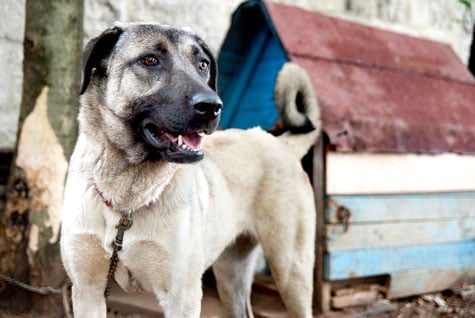
The most powerful type of mastiff is known as the Kangal dog, or Anatolian Shepherd. This powerful Mastiff type dog is native to Turkey and has the primary duty of protecting against animal predators.
They are massive dogs with equally massive jaws and their bite pressure can be as high as 740 PSI. These dogs should not be kept around other dogs or pets, as they will never be predictably well-behaved with them.
Bandog Dog
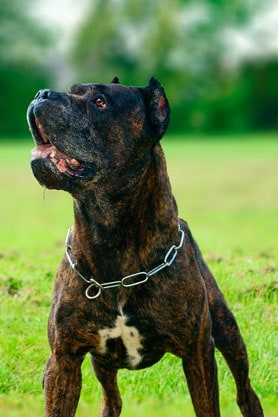
This unusual breed is a mix between a Mastiff and a Bulldog, bred to protect their families from people or animals. This is a dog who will lay down his life to protect his family. These dogs require extensive socialization and careful control throughout their lives. The bite force of a bandog is 730 PSI.
Cane Corso
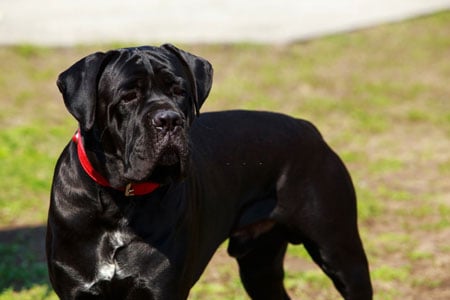
The Cane Corso is a powerful Italian dog bred to protect and fight for their owners. These tough dogs have a bite force of about 700 PSI and are not the least bit afraid to use all of that pressure to defend their family. If you want a Cane Corso in your home, be sure to carefully socialize them and control their movements around strangers.
Dogue de Bordeaux
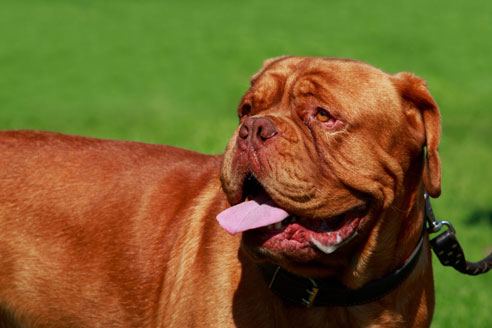
This French Mastiff is well known for being especially good with kids, although they are also prone to extensive drooling. These dogs tend to do very well with their families but are passionately protective. The short snout packs a serious punch of about 556 PSI.
Tosa Inu
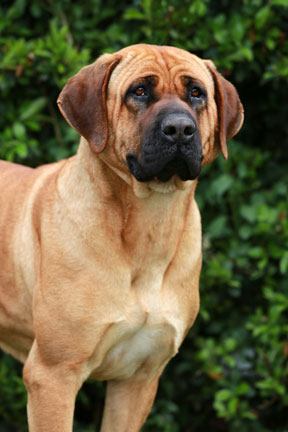
This Japanese Mastiff also has some Bulldog and Great Dane ancestry. They are determined protection dogs who need careful socialization with new people. These strong dogs have a bite pressure of around 556 PSI.
Other dogs with powerful bites
Other groups of dogs do not compare to the Mastiff with biting strength, but they are still worth mentioning. Here are some dogs with a powerful bite.
Dogo Argentino
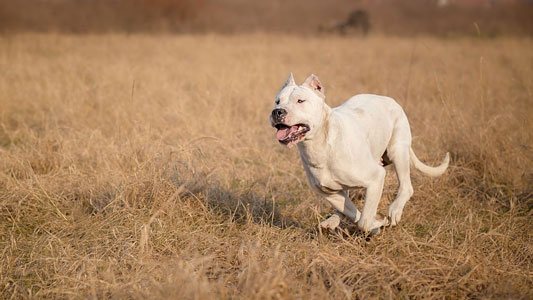
This national dog of Argentina was bred to be a game hunting dog and combines many of the features of a powerful dog like a Mastiff with a hunting dog like a hound. These dogs can be strong-willed but are well-known for being good family dogs when well socialized. They may not ever be trustworthy with other animals. The bite force of the Dogo Argentino is about 500 PSI.
Rottweiler
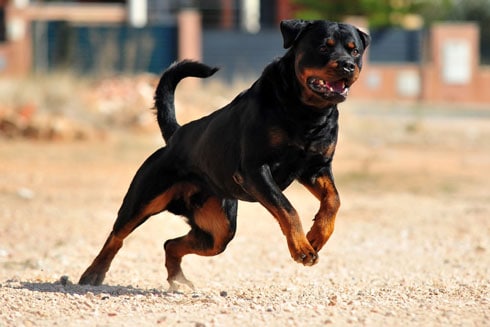
Rottweilers are descended from Mastiffs and also have a massive head and jaw, so it should come as no surprise that they pack an impressive bite pressure of around 328. They are an ancient breed and while they tend to be very loving with their family, they may occasionally be unpredictable. It is essential to carefully socialize your Rottweiler and teach your children safe practices around this powerful breed if you choose to have one in your home.
American Bulldog
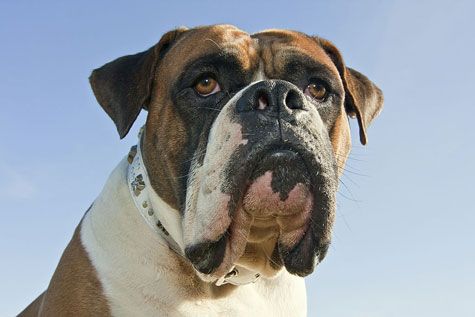
This all american dog was developed in the American South in order to herd livestock such as cattle and to hunt feral pigs. These dogs love their families and are wonderful with children. They tend to be quite sensitive in training. The American bulldog has a bite force of around 305 PSI.
German Shepherd
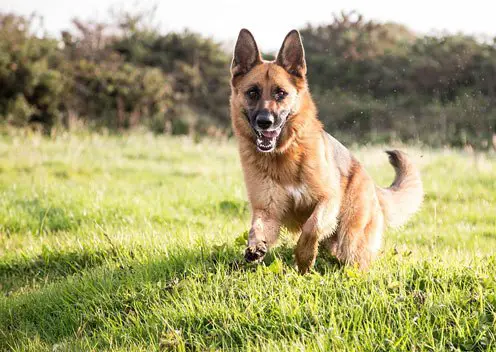
The German Shepherd is the quintessential all-around working dog. They are extremely trainable and can learn to do almost any job that you need them to do. While large and strong, these dogs do not have the jaw to impart the kind of strength of Mastiff type dogs. They have a bite force of around 238 PSI.
Pitbull
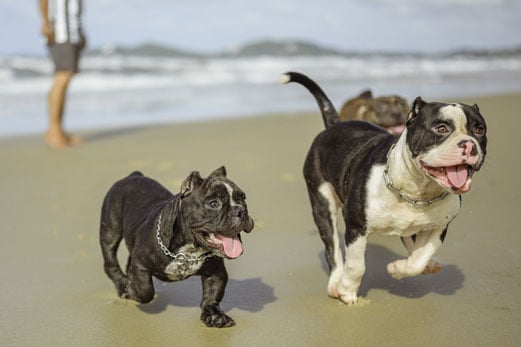
Despite its reputation as one of the most dangerous dogs in America and the dog next to mixed breed dogs that has the highest record for actual bites, the American Pitbull actually does not have nearly as strong a bite as you may think. The Pitbull is not a big dog and although their jaws take up a lot of their face, their jaws do not end up being nearly as big as some other breeds.
Therefore, the Pitbull has a bite force of only 235 PSI. Contrary to popular belief, the Pitbull does not have locking jaws. Their jaws are just the same as any other dog. However, fighting dogs are trained to hold a bite and this characteristic is often present in the breed.
Dog breeds most likely to bite
Every dog has the potential to bite, no matter how sweet and well-behaved they may be. However, statistics find that certain dogs are more likely to bite than others. 15 years of dog related facial trauma to 240 patients, mostly children, were analyzed in order to determine which breeds were most likely to bite and how severe their bites were.
Of interest was not just which breeds were most likely to bite, but which breeds inflicted the most damaging bite. The study examined various features in order to determine the severity of bites.
When breed was not clear, for instance when the dog was a mixed breed dog, additional factors like the physical shape of the dog’s head and mouth were used. Unknown breeds top the list of breed of dog to bite since this information is often not collected. That said, here are the results based on the information about dog breeds that was collected..
Dogs with short, wide heads who weigh between 66 and 100 lbs were most likely to bite
The majority of reported bites came from Pitbull dogs, with 22.5% of bites coming from this breed. Mixed breed dogs followed with 21.2%, and German Shepherds were third at 17.8%. Terriers and Rottweilers followed as most likely to bite.
Both mixed breed dogs and Pitbulls had the highest risk of biting and the most damage for a bite. Remember that bite strength is tied to the size of the jaw and dog, so it makes sense that larger dogs with big heads and jaws are the most likely to do the most damage. This also explains another finding, which is that Great Dane and Akita were both found to inflict a high average damage for their bites, although they had a relatively low risk of biting. This is because these dogs have such large heads and jaws that the probability of them doing a lot of damage when they bite is high, even if they don’t bite often.
What can we learn from the research?
It is important to understand which dogs can inflict the most damage with their bites and which dogs are most likely to bite. This does not mean that any dog with these physical characteristics is more likely to bite then another dog on average. Many elements can go into these results.
For instance, when you consider that Pitbull dogs and mixed breed dogs are much more common in the shelter system and are much more likely to be the result of backyard and irresponsible breeding practices, it may make more sense that these types of dogs are more likely to inflict injury.
However, if you are considering any large dog with a short snout and powerful jaws for your family home, it is even more essential for you than for the average dog owner that you are dedicated to monitoring your children’s interactions with the dog and teaching your children safe habits with dogs.
Most severe bites in the US come from children interacting with large dogs with short snouts and large jaws, often as a result of children teasing the dog. In most studies, it is the child who initiated the interaction which ended with a bite. Teach your children how to interact properly with dogs, especially if you want a dog with a strong bite.
